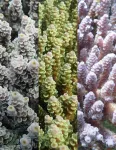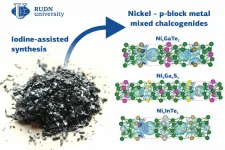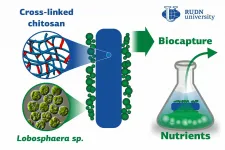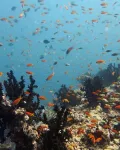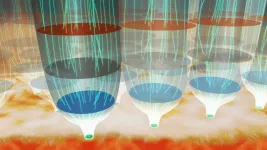(Press-News.org) Coral within the family Acropora are fast growers and thus important for reef growth, island formation, and coastal protection but, due to global environmental pressures, are in decline
A species within this family has three different color morphs - brown, yellow-green, and purple, which appear to respond differently to high temperatures
Researchers looked at the different proteins expressed by the different color morphs, to see whether these were related to their resilience to a changing environment
The green variant was found to maintain high levels of green fluorescent proteins during summer heatwaves and was less likely to bleach than the other two morphs
This suggest that resistance to thermal stress is influenced by a coral's underlying genetics, which, coincidentally, also lead to the different color morphs
Anyone who visits the Great Barrier Reef in Australia, Southeast Asia's coral triangle, or the reefs of Central America, will surely speak of how stunning and vibrant these environments are. Indeed, coral reefs are believed to house more biodiversity than any other ecosystem on the planet, with the coral providing protection and shelter for hundreds of species of fish and crustaceans.
But these ecosystems are under threat. Global pressures, such as rising ocean temperatures, are causing coral to turn ghostly white, a phenomenon called bleaching, and die. One family of coral - Acropora - seems to be particularly susceptible and its numbers are expected to decline in the future. This is especially concerning as these corals are fast growers and thus structurally important for the reefs. Researchers took a close look at Acropora tenuis, a species within this family, which is known to have three color morphs - brown, purple, and yellow-green. Their new study, published in G3: Genes|Genomes|Genetics, indicates that these color morphs speak of the coral's resilience to high temperatures, and found the underlying genetic factors that seem to be responsible for this.
"Coral reefs are very beautiful and have a whole variety of different colors," said Professor Noriyuki Satoh, who leads the Marine Genomics Unit at the Okinawa Institute of Science and Technology Graduate University (OIST). "When we started looking at the different color morphs of A. tenuis we noticed that some morphs bleach more readily and die more frequently than others. During the summer of 2017, we saw that many of the brown and purple morphs bleached, with the brown morph dying at a higher rate, but the yellow-green morph seemed to show resilience to the summer temperatures."
The Unit worked with several individuals from the Okinawan community, including Koji Kinjo from Sea Seed, who directs a private aquarium where the different color morphs have been grown for around 20 years. This aquarium was instrumental for the researchers to observe the coral over the last two decades and to determine how resilient this species is to climate change, and the underlying causes.
In 2020, Professor Satoh and his collaborators decoded the genome of A. tenuis, which provided them with the toolkit for this research, allowing them to look at the genetic foundations that cause the different morphs.
"At first, we thought the difference in resilience might be linked to the corals housing different kinds of symbiotic algae, which photosynthesize for the coral and thus provide the coral with energy. Previous research has shown that some symbiotic algae are more resilient to climate change than others. But when we looked at the three-color morphs, we found that they all housed very similar algae," explained Professor Satoh.
With this in mind, the research group instead focused the expression levels of the proteins that are thought responsible for the coral's color. There are four different groups of these proteins - green fluorescent proteins (GFP), red fluorescent proteins (RFP), cyan fluorescent proteins (CFP), and non-fluorescent blue/purple chromoproteins (ChrP). The researchers looked at the gene expression levels of five types of GFP, three types of RFP, two types of CFP and seven types of ChrP in several coral in each morph.
As can be expected, they found that the green morph expressed high quantities of FGPs, but the researchers found that two of the five were expressed at particularly high levels. More surprising was that these two proteins were expressed at even higher levels during summer, which indicates that they help the coral to withstand warmer temperatures. Specifically, these proteins seemed to protect the symbiotic algae, which meant that this color morph experienced very little bleaching.
In contrast, the corals with the brown color morph, which express much lower quantities of these two proteins, bleached by around 50% over July and August 2017.
The purple morph was different again. It expressed very little of any of the fluorescent proteins, but much higher levels of Chrp. The corals with this color morph bleached at levels in between that seen in corals with the brown morph and that seen in corals with the green morph.
"Coral reefs are so important for biodiversity," concluded Professor Satoh. "Finding out more about them will help us to conserve them. Right now, we cannot help so much about the coral reef situation but gathering this fundamental knowledge, understanding how corals work, is very important for long-term conservation."
This research has showcased that the color morphology of coral is very much involved in its response to high temperatures. The underlying reasons behind this, such as exactly how the green fluorescent protein protects the symbiosis, will no doubt be the topic of research in the future.
INFORMATION:
Professor Satoh and his Unit worked with people from Umino-Tane Co. LTD, IDEA Consultants, Inc., and Okinawa Environmental Research Co., Ltd., as well as researchers from the University of Tokyo. In addition, OIST's DNA Sequencing Section and Imaging Section were also involved in this project.
Periodic pulses of light forming a comb in the frequency domain are
widely used for sensing and ranging. The key to the miniaturisation of
this technology towards chip-integrated solutions is the generation of
dissipative solitons in ring-shaped microresonators. Dissipative solitons
are stable pulses circulating around the circumference of a nonlinear
resonator.
Since their first demonstration, the process of dissipative soliton
formation has been extensively studied and today it is rather
considered as textbook knowledge. Several directions of further
development are ...
A survey by a Boston University researcher of nearly 33,000 college students across the country reveals the prevalence of depression and anxiety in young people continues to increase, now reaching its highest levels, a sign of the mounting stress factors due to the coronavirus pandemic, political unrest, and systemic racism and inequality.
"Half of students in fall 2020 screened positive for depression and/or anxiety," says END ...
Microorganisms possess natural product biosynthetic gene clusters (BGCs) that may harbor unique bioactivities for use in drug development and agricultural applications. However, many uncharacterized microbial BGCs remain inaccessible. Researchers at University of Illinois Urbana-Champaign previously demonstrated a technique using transcription factor decoys to activate large, silent BGCs in bacteria to aid in natural product discovery.
Now, they have developed a direct cloning method that aims to accelerate large-scale discovery of novel natural products. Their findings are reported in the journal Nature Communications.
Named Cas12a assisted precise targeted cloning using in vivo Cre-lox recombination (CAPTURE), ...
DURHAM, N.C. -- Duke researchers have been studying something that happens too slowly for our eyes to see. A team in biologist Philip Benfey's lab wanted to see how plant roots burrow into the soil. So they set up a camera on rice seeds sprouting in clear gel, taking a new picture every 15 minutes for several days after germination.
When they played their footage back at 15 frames per second, compressing 100 hours of growth into less than a minute, they saw that rice roots use a trick to gain their first foothold in the soil: their growing tips make ...
A chemist from RUDN University, working with a group of colleagues, synthesized three new chalcogenides (compounds that contain metals and elements from group 16 of the periodic table). The team suggested an unusual approach to synthesis that was based on iodine. An article about the work was published in the Dalton Transactions journal.
Chalcogens are elements of group 16 of the periodic table that include oxygen, sulfur, selenium, tellurium, polonium, and livermorium--an artificial radioactive element. Chalcogenides are compounds of chalcogens with metals that are used as photosensitive ...
Several University of Illinois Chicago faculty members have addressed the issue of how to ethically conduct research with Black populations.
In their paper "Ethics of Research at the Intersection of COVID-19 and Black Lives Matter: A Call to Action," authors Natasha Crooks, an assistant professor, Phoenix Matthews, a professor, both of the UIC College of Nursing, and Geri Donenberg, director of the Center for Dissemination and Implementation Science at the UIC College of Medicine, highlight the historical issues that impact research involving Black populations. They also provide recommendations for researchers to ethically engage Black populations in research. ...
Biotechnologists from RUDN University in collaboration with Lomonosov MSU and Kurchatov institute made an important contribution to the technology of phosphate and nitrate biocapture from wastewater using Lobosphaera algae fixed on the filters.The biomass obtained in the course of this process can be used as a fertilizer. The results of the study were published in the Journal of Water Process Engineering.
Phosphates and nitrates get to the wastewater together with industrial and household waste, especially detergents. Both substances are parts of phosphorus and nitrogen chemical cycles. However, these cycles are disturbed by human activity, as the growing amounts of phosphates and nitrates cannot be processed by water ecosystems. As a result, these substances turn from useful nutrients ...
New Orleans, LA - A retrospective study conducted by LSU Health New Orleans reports that contrary to previous research, most patients who drop out of peritoneal dialysis may do so for psychosocial reasons. The findings are published in The American Journal of the Medical Sciences, available here. The paper inspired a companion editorial, available here.
The research team evaluated the reasons that 27 of the 83 patients enrolled in the peritoneal dialysis program withdrew between 2016 and 2018. Twenty-four or 86% were African American. They found that psychosocial factors, including mental health illness such as anxiety and depression, loss of support networks, or inability to tolerate ...
Since Charles Darwin's day, the abundance of life on coral reefs has been puzzling, given that most oceanic surface waters in the tropics are low in nutrients and unproductive.
But now research, led by Newcastle University and published in in the journal Science Advances, has confirmed that the food web of a coral reef in the Maldives relies heavily on what comes in from the open ocean.
The team found that these offshore resources contribute to more than 70% of reef predator diets, the rest being derived from reef associated sources.
Led by Dr Christina Skinner, now based at the Hong Kong University of Science and Technology, the researchers included collaborators from Woods Hole Oceanographic Institution (USA), Banyan Tree Marine ...
Cooperative operations between a solar observation satellite and a sounding-rocket telescope have measured the magnetic field strength in the photosphere and chromosphere above an active solar plage region. This is the first time that the magnetic field in the chromosphere has been charted all the way up to its top. This finding brings us closer to understanding how energy is transferred between layers of the Sun.
Despite being the brightest object in the sky, the Sun still holds many mysteries for astronomers. It is generally believed that magnetic fields play an important role in heating the solar corona, but the details of the process are still unclear. To solve this mystery it is important to understand the magnetic field in the chromosphere, which is sandwiched ...
